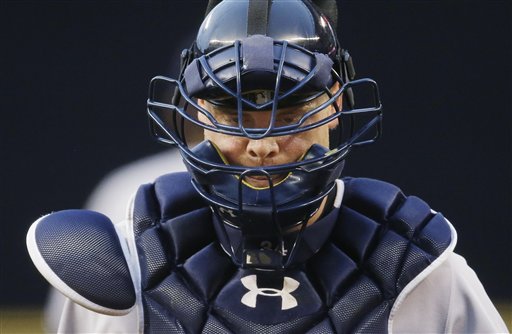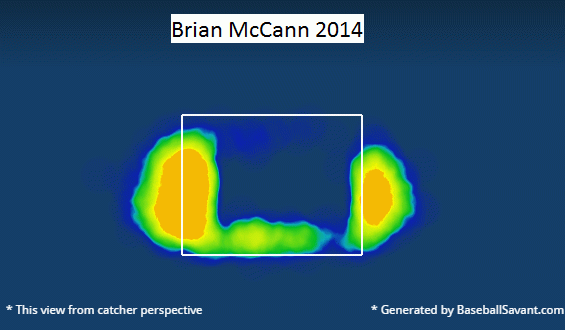
Last year when Brian McCann suffered through perhaps his worst offensive campaign as a major-leaguer with a career-low OPS of .692, the one thing that kept his season from being a complete disaster was his strong defense behind the plate. He ranked sixth in caught stealing percentage, and according to the various catcher framing metrics, he was among the elite in stealing strikes.
It’s been a different story this year for McCann. While he’s back to bashing baseballs and putting up his customary above-average offensive numbers, his glovework has been a mixed bag. Yes, he’s still throwing out runners at a high rate, but his pitch framing skills have declined sharply.
There are two catcher framing models — one from the Baseball Prospectus folks and one at StatCorner.com — and both agree that McCann has surprisingly been a poor receiver behind the plate this year.
For the first time in his career (or at least since data became available in 2008), his framing stats are below average and he’s actually losing strikes — i.e. getting fewer called strikes than predicted by the various framing models.
Last season McCann was really good at both stealing strikes outside the zone and getting correct strike calls on pitches that are taken within the zone. Baseball Prospectus credited him with 69 extra strikes gained from his ability to frame pitches outside the zone (16th in MLB); StatCorner calculated that only 10 percent of the pitches he caught within the defined strike zone were called balls, the fifth-best rate among qualified catchers last year.
This season, each of those numbers are in the red and much worse than last year. BP has him with -2 framing runs — meaning he has cost the team two runs based on his poor receiving work — while StatCorner is slightly more optimistic at -0.7 runs. He’s gotten 13 fewer strikes than expected while his rate of called balls within the zone has jumped to 13 percent. Although the raw number of “lost” strikes seems low (13), all it takes is one extra pitch for a batter to deliver a game-changing hit and give away a potential win. That’s baseball, folks.
Digging into the numbers using Baseball Savant’s pitch f/x tool, we can try to figure out where exactly McCann has struggled in stealing strikes outside the zone this year compared to last year. As you can see in the called strike pitch heat maps below, it appears that he’s been less effective in getting calls on pitches to his non-glove side — on the outside corner to right-handed batters and inside to lefties (focus more on the changes in the shapes of the blobs, not the colors):
There are a couple potential theories to explain McCann’s troubles with framing pitches this year. As the catcher told FanGraphs’ writer Eno Sarris earlier this month, framing is an athletic skill. “You have to have soft hands, and when the ball hits your glove, your wrist can’t move,” explained McCann. When a catcher ages — McCann turned 31 years old this winter — he loses the athleticism and physical skills, along with the critical flexibility, needed to properly execute the framing techniques.
It’s also possible that this year’s pitching staff has thrown him fewer “frameable” pitches. While most analysts agree that the catcher plays a significant part in getting borderline strike calls, framing is a two-way street. The pitcher also has to be able to paint edges with pitches that are just enough off the plate so the batter doesn’t swing but close enough to the zone that the catcher can make it look like a strike.
Regardless of the reasons why McCann is struggling with his pitch framing this year, there is little doubt based on the metrics that his skills have eroded. While the actual impact of these lost strikes on the outcome of a game might seem subtle, we know that one pitch can be the difference between a win and a loss, and one win can be the difference between making the playoffs and playing golf in October.


Leave a Reply
You must be logged in to post a comment.